14
UNIT MAINTENANCE
Proper maintenance is most important to achieve the best
performance from a air handler. Some of the components
and their locations are shown in Figure 12 (page 16). If
any component of the air handler must be replaced, use
only factory authorized replacement parts specified in the
Replacement Parts List provided online.
WARNING:
ELECTRICAL SHOCK, FIRE OR
EXPLOSION HAZARD
Failure to follow safety warnings exactly could
result in serious injury or property damage.
Improper servicing could result in dangerous
operation, serious injury, death or property
damage.
• Beforeservicing,disconnectallelectricalpower
to the indoor blower.
• Whenservicingcontrols,labelallwiresprior
to disconnecting. Reconnect wires correctly.
• Verifyproperoperationafterservicing.
• These maintenance instructions are primarily intended
to assist qualified technicians experienced in the proper
maintenance and operation of this appliance.
• Alwaysreinstallthedoorsontheairhandlerafterservicing
or cleaning/changing the filters. Do not operate the air
handler without all doors and covers in place.
• Verify that the thermostat is properly installed and is
not being affected by drafts or heat from lamps or other
appliances.
• Toachievethebestperformanceandminimizeequipment
failure, it is recommended that a yearly maintenance
checkup be performed. At a minimum, this check should
include the following items:
Air Filter(s) - B6 Series Air Handlers are not supplied
with a single air filter when shipped from the factory. It
is recommended that the filter be cleaned or replaced
every 4 to 6 months at a minimum. Newly built or recently
renovated homes may require more frequent changing until
the construction dust has minimized. Filter sizes shown in
Table 2 are available at most local retailers.
WARNING:
Never operate the air handler without a filter in
place. Dust and lint in the return air can build
up on internal components, resulting in loss of
efficiency, equipment damage, and possible fire.
Filters designed to remove smaller particles such as pollen,
may require additional maintenance.
Blower Compartment - Dirt and lint can create excessive
loads on the motor resulting in higher than normal operating
temperatures and shortened service life. It is recommended
that the blower compartment be cleaned of dirt or lint that
may have accumulated in the compartment or on the blower
and motor as part of the annual inspection.
Blower Fan Wheel - Inspect the blower wheel blades for
accumulations of dirt and clean if necessary. Inspect mounting
nut for tightness when done.
Blower Motor & Assembly - Inspect the blower assembly
and motor mounting brackets for tightness and corrosion.
Correct deficiencies if necessary. The blower motor contains
sealed bearings and under normal operating conditions,
no maintenance is necessary for the life of the equipment.
TROUBLESHOOTING
If the air handler fails to operate, check the following:
• Istheelectricturnedon?
• Isthethermostatoperatingproperly?
• Aretheblowercompartmentdoor(s)inplace?
• Istheairhandlerdisconnectclosed?
• Hasthecircuitbreakertrippedorthecontrolboardfuse
burnedopen?
• Areanymanualresetswitchesopen?
• Isthelterdirtyorplugged?
• IstheLEDonbothcontrolboardsconstantlyON?Ifnot,
refer to Table 3 or Table 4 to determine fault condition.
Table 2.
Filter Sizes
CABINET SIZE FILTER SIZE
A 12 x 20 x 1
B 18 x 20 x 1
C 20 x 20 x 1
RED LED (AN2) DIAGNOSTIC
OFF Control Fault (No Power)
Flash Blower Fault
ON Normal Operation
Table 3. Air handler Control Board Fault Conditions
Table 4. Motor Control Board Fault Conditions
DIAGNOSTIC
GREEN
LED
RED
LED
FIXED
SPEED
FURNACES
Control Fault (No Power) Off Off
Normal Operation On On
Motor Fault On Flash
Twin Fault (no motor fault) Flash On
Communications Fault Flash Flash
VARIABLE
SPEED
FURNACES
Control Fault (No Power) Off Off
Normal Operation On On
Motor Fault On Flash
Communications Fault Flash Flash

